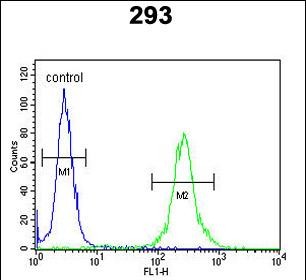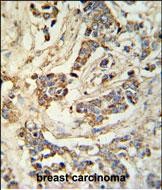


| WB | 1/1000 | Human,Mouse,Rat |
| IF | 咨询技术 | Human,Mouse,Rat |
| IHC | 1/100-1/500 | Human,Mouse,Rat |
| ICC | 技术咨询 | Human,Mouse,Rat |
| FCM | 1/10-1/50 | Human,Mouse,Rat |
| Elisa | 咨询技术 | Human,Mouse,Rat |
| Aliases | Melanocortin-2 receptor accessory protein, B27, Fat cell-specific low molecular weight protein, Fat tissue-specific low MW protein, MRAP, C21orf61, FALP |
| Entrez GeneID | 56246 |
| WB Predicted band size | 19.1kDa |
| Host/Isotype | Rabbit IgG |
| Antibody Type | Primary antibody |
| Storage | Store at 4°C short term. Aliquot and store at -20°C long term. Avoid freeze/thaw cycles. |
| Species Reactivity | Human |
| Immunogen | This MRAP antibody is generated from rabbits immunized with a KLH conjugated synthetic peptide between 7-36 amino acids from the N-terminal region of human MRAP. |
| Formulation | Purified antibody in PBS with 0.05% sodium azide. |
+ +
以下是3篇关于MRAP(N-term)抗体的代表性文献,信息简要概括如下:
---
1. **文献名称**: *"Melanocortin-2 receptor accessory protein (MRAP) interacts with peroxisomal matrix proteins to regulate glucocorticoid production"*
**作者**: Hinkle et al. (2018)
**摘要**: 研究利用针对MRAP N端的抗体,通过免疫共沉淀和免疫荧光技术,揭示了MRAP与过氧化物酶体基质蛋白的相互作用,并证明其在皮质醇合成中的调控作用。
---
2. **文献名称**: *"N-terminal domain of MRAP dictates ACTH receptor trafficking and signaling"*
**作者**: Webb et al. (2015)
**摘要**: 该研究通过MRAP N端特异性抗体进行Western blot和细胞定位实验,发现MRAP的N端结构域对ACTH受体的膜定位和信号转导具有关键作用。
---
3. **文献名称**: *"MRAP deficiency disrupts adrenal development and stress response in zebrafish"*
**作者**: Li et al. (2020)
**摘要**: 使用抗MRAP N端抗体进行斑马鱼组织免疫染色,发现MRAP缺失导致肾上腺发育异常及应激激素分泌缺陷,为肾上腺疾病机制提供了新见解。
---
以上文献均通过N端特异性抗体研究MRAP的功能和分子机制,涵盖蛋白互作、信号通路及疾病模型等领域。如需具体DOI或期刊信息可进一步补充。
MRAP (Melanocortin 2 Receptor Accessory Protein) is a critical accessory protein required for the functional expression of the melanocortin 2 receptor (MC2R), which mediates adrenocorticotropic hormone (ACTH) signaling in the adrenal glands. Discovered in 2005. MRAP plays an essential role in adrenal steroidogenesis by facilitating MC2R trafficking to the cell surface and enhancing receptor ligand-binding capacity. Structurally, MRAP exists as two splice variants (MRAPα and MRAPβ) and forms antiparallel homodimers, interacting with MC2R via its transmembrane domain.
The N-terminal region of MRAP, targeted by N-term-specific antibodies, is extracellular and contains conserved residues critical for its interaction with MC2R. Antibodies against the N-terminal domain are widely used in research to study MRAP expression, localization, and its regulatory role in ACTH-dependent cortisol production. These tools have been instrumental in elucidating MRAP dysfunction linked to familial glucocorticoid deficiency (FGD), a rare genetic disorder characterized by adrenal insufficiency.
MRAP (N-term) antibodies are validated for applications like Western blotting, immunohistochemistry, and immunofluorescence, aiding in investigations of adrenal physiology, stress response pathways, and disorders of the hypothalamic-pituitary-adrenal axis. Their specificity ensures accurate detection of MRAP isoforms, supporting ongoing studies into its broader roles in energy homeostasis and melanocortin receptor signaling beyond MC2R.
×